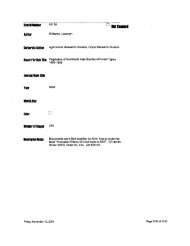Epidemiologic Investigation of Health Effects in Air Force Personnel ...
Epidemiologic Investigation of Health Effects in Air Force Personnel ...
Epidemiologic Investigation of Health Effects in Air Force Personnel ...
Create successful ePaper yourself
Turn your PDF publications into a flip-book with our unique Google optimized e-Paper software.
Referr<strong>in</strong>g aga<strong>in</strong> to Figure 4, R and C <strong>in</strong>dicate liv<strong>in</strong>g RANCH HAND members<br />
and primary matched controls. If ITIR' is the proportion <strong>of</strong> R' found to<br />
be deceased, then<br />
R » (1 - m R ')R'<br />
The questionnaire will provide data concern<strong>in</strong>g specific symptoms and<br />
other f<strong>in</strong>d<strong>in</strong>gs <strong>in</strong> the R and C groups. Thus, various questionnaire f<strong>in</strong>d<strong>in</strong>g<br />
rates <strong>in</strong> R, SR, will be calculated and compared with the correspond<strong>in</strong>g rates<br />
<strong>in</strong> C, so<br />
The questionnaire will allow allocation <strong>of</strong> RANCH HAND personnel <strong>in</strong>to<br />
those with symptoms on questionnaire, <strong>in</strong>dicated by RS, and those without, R.<br />
Similarly, the control Jndividuals will be placed <strong>in</strong>to symptomatic, <strong>in</strong>dicated<br />
CS, and asymptomatic, C"$" groups.<br />
The physical exam<strong>in</strong>ation performed on <strong>in</strong>dividuals from R and C will<br />
allow estimation and comparison <strong>of</strong> rates <strong>of</strong> physical f<strong>in</strong>d<strong>in</strong>gs <strong>in</strong> these<br />
groups. Rates <strong>of</strong> abnormal physical f<strong>in</strong>d<strong>in</strong>gs can be symbolically <strong>in</strong>dicated as<br />
fR and fc for RANCH HAND and control groups respectively. Comparison <strong>of</strong><br />
these rates is very important and details will be discussed below.<br />
Let fRs be the rate <strong>of</strong> physical f<strong>in</strong>d<strong>in</strong>gs among RANCH HAND personnel<br />
with f<strong>in</strong>d<strong>in</strong>gs by questionnaire and let fR$ be the rate <strong>of</strong> physical f<strong>in</strong>d<strong>in</strong>gs<br />
among RANCH HAND people with no f<strong>in</strong>d<strong>in</strong>gs on their questionnaire. For most<br />
disease processes it would be expected that fR$ should be a larger rate than<br />
fRS*. If fRS is observe 1 ! to be equal to or less than fR$", an <strong>in</strong>terpretation<br />
<strong>of</strong> over-report<strong>in</strong>g may be warranted, although the possibility <strong>of</strong> subcl<strong>in</strong>ical<br />
disease is recognized. Rates fcs and ^CS" w^l a^so be estimated, and<br />
comparisons between fR$, fc$> fR$ and fc$"will be accomplished.<br />
The eight rates IDR', me', SR, SQ, fRs» fRs", fcs,<br />
f CS;<br />
and their ref<strong>in</strong>ements fully characterize this study. As depicted <strong>in</strong> Figure 4,<br />
"vertical comparisons <strong>of</strong> these rates provide relative risks mR'/mc''<br />
S R/ S C»<br />
f R/fc» fRS/ f and<br />
CS fRS/fcs" which are <strong>of</strong> central importance<br />
<strong>in</strong> def<strong>in</strong><strong>in</strong>g herbicide effects. "Horizontal comparisons" relate fR to<br />
SR, f RS to f R s, fc to sj and f cs to f cs **. Specifically, the<br />
ratio fR/SR is the ratio <strong>of</strong> physical f<strong>in</strong>d<strong>in</strong>gs to reported symptoms <strong>in</strong> the<br />
RANCH HAND population. This ratio may be contrasted with the ratio fg/sr,<br />
and if fR/SR is less than fc/sc over-report<strong>in</strong>g is suggested. Likewise,<br />
if fRs is less than fR^", over-report<strong>in</strong>g is further suggested. A<br />
comparison <strong>of</strong> fRS/fRS to fCS/^CS contrasts the odds <strong>of</strong> f<strong>in</strong>d<strong>in</strong>gs given<br />
symptoms <strong>in</strong> the RANCH HAND population with the odds <strong>of</strong> f<strong>in</strong>d<strong>in</strong>gs given symptoms<br />
<strong>in</strong> the control group. If these odds are lower <strong>in</strong> the RANCH HAND group, overreport<strong>in</strong>g<br />
is aga<strong>in</strong> implied. Further discussion <strong>of</strong> these rates is presented <strong>in</strong><br />
Section V.G.<br />
Dur<strong>in</strong>g the questionnaire and physical exam<strong>in</strong>ation phases <strong>of</strong> this<br />
study, only one <strong>of</strong> the five randomly selected mortality study controls will be<br />
used for each RANCH HAND <strong>in</strong>dividual. If this control is unwill<strong>in</strong>g to participate,<br />
another mortality study control will be used as <strong>in</strong>dicated <strong>in</strong> Figures 3<br />
30
















